Keith Haring: Street art on a banknote ?
Back in 2022, an old 100 Belgian franc note dedicated by the artist Keith Haring in 1989 found its way to the NBB Museum. What was the background to this initiative ?
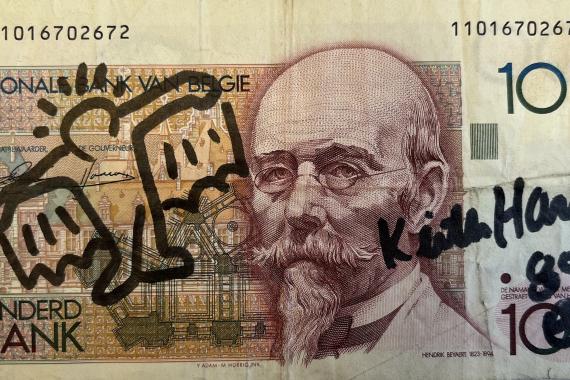
In 2022, our museum acquired an old 100 Belgian franc banknote dedicated by the artist Keith Haring in 1989 on one of his visits to Belgium. In this article, we will come back to the career path of this artist of international renown, while taking a closer look at this famous banknote bearing the image of architect Henri Beyaert. Renowned for his characters with such surprising and specific graphics, Keith Haring also stood out from others with the huge symbolic dimension present in his works of art. How can this kind of achievement be put into context ?
A man called Keith Haring
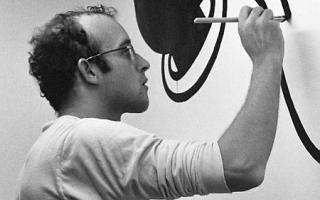
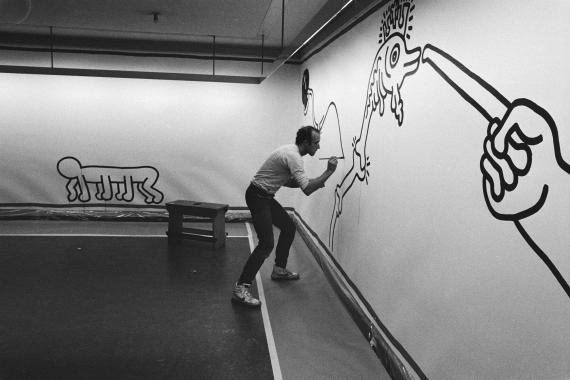
Born on 4 May 1958 in Reading, in the State of Pennsylvania, Keith Haring developed a great passion for drawing at an early age. He soon descended upon New York, where he came to socialize in hip-hop and graffiti circles. There, he found a kind of freedom, far from the art galleries and other museum institutions.
The early 1980s were a turning point in the popularity of the artist. Often criticised for his drawings that were felt to be too childish, Keith Haring made a name for himself thanks to his works of art in the New York subway. He took a particular liking to the black vinyl advertising hoardings that had been left in disrepair by the American city. At the time, it was possible to admire the white chalk drawings that were so characteristic of the artist, backed up by slogans like “Art in Transit” or “Crack is Wack”. Many art gallery owners and other collectors were soon rushing in to pick up art works by the Pennsylvanian native and literally bring out his street art, propelling him to the forefront of the art scene. His closeness to Andy Warhol, the leader of the Pop Art movement only served to strengthen his intent to make his art accessible to everyone! The second half of the 1980s saw the artist export outside the United States. For example, he painted a mural fresco at the Necker-Enfants Malades Hospital in Paris in 1987 and also went to Belgium in 1987 and 1989, where he produced numerous works of art.
As a committed activist, Keith Haring’s work broached universal and topical causes such as the fight against inequality and racism or for research into treatment for AIDS. Keith Haring died on 16 February 1990 of complications related to the same disease, having been diagnosed three years earlier. As a legacy, he left his Keith Haring Foundation, administering the rights to his works, but above all financing research into a cure for AIDS.
The autographed banknote
At a personal exhibition in June 1989, Keith Haring was at Antwerp’s Gallery 121 and was happy to sign autographs. One of the visitors to this exhibition apparently asked the artist to dedicate his 100 Belgian franc note. Why choose such a medium ? The owner of the banknote had nothing else on him to give to the artist to sign or maybe it was a request from the artist himself ?
No matter what, Keith Haring placed his signature on the banknote, and the date on which it was signed abbreviated by a simple “89” with a sort of round mark in which the symbol “+” can be observed. This recurrent symbol in the art work by Keith Haring backs up his signature and can serve as authentication. In the upper left corner of the banknote, the artist drew a winged man, that may represent Icarus getting burnt by the sun and the decline of human society, according to the most popular interpretation by the scientific community. The artist’s critical view of society is never far away. Keith was anything but a beginner and dedicated and adorned many banknotes throughout his career. Given the popular nature of a banknote and the critical form of Haring’s work, it is highly likely that this was probably a deliberate act by the artist. What can be more used than a banknote ? And above all, what could be more interesting than to criticize a capitalist society’s monetary system ?
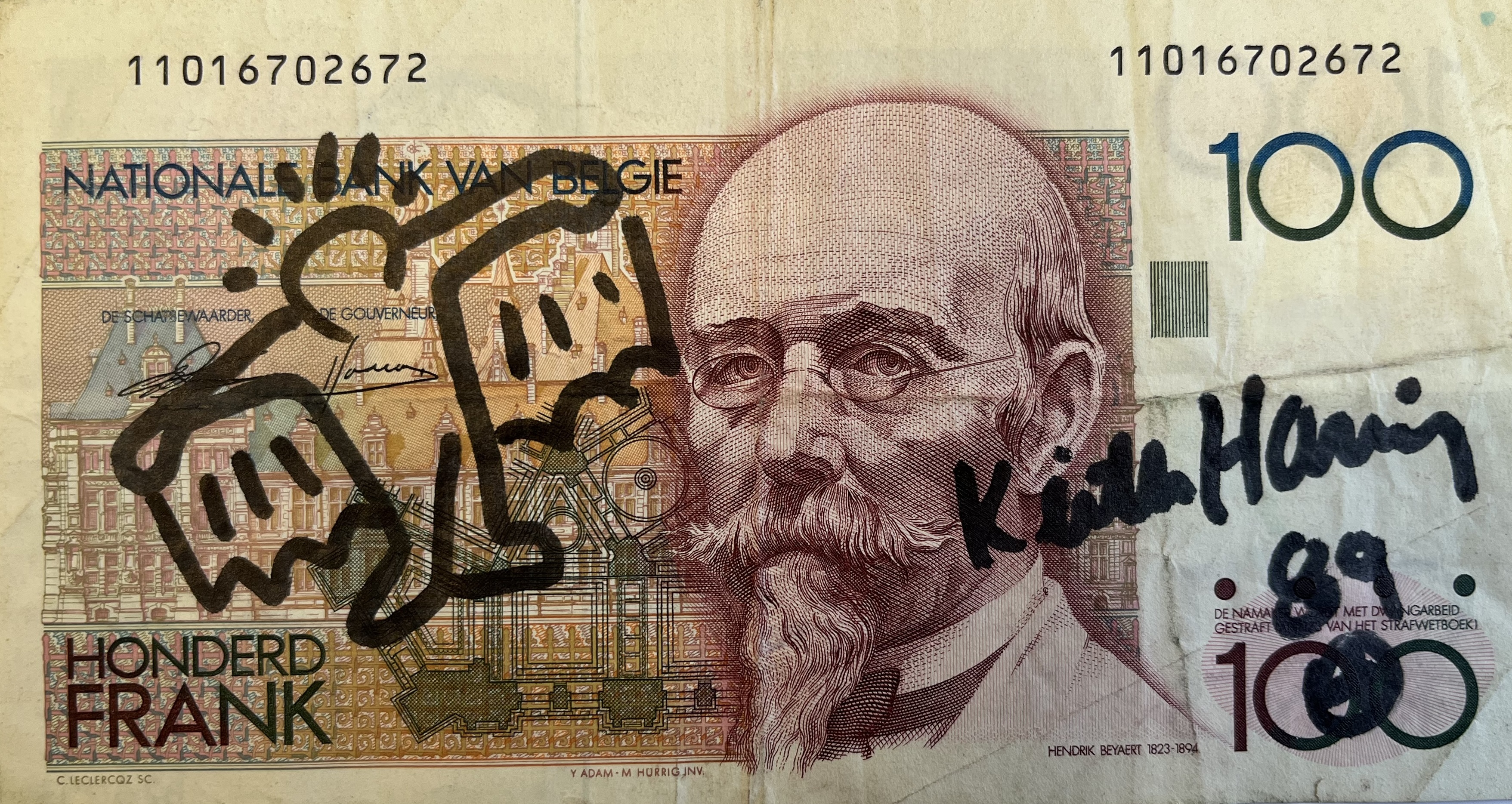
Another artist on the banknote: Henri Beyaert
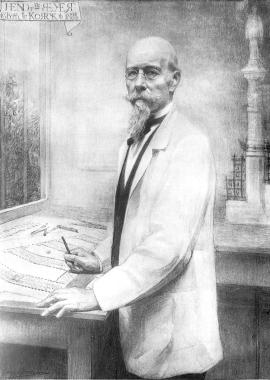
Keith Haring did not use an insignificant medium to design his caricature. He used the most popular denomination of the penultimate series of Belgian franc notes issued by the National Bank of Belgium. So, this is a good reason to focus on the personality of Henri Beyaert and the design of the banknote depicting his image.
Henri Beyaert (1823-1894) was one of the most influential architects that Belgium has ever seen. Eclecticism and the free combination of architectural innovation and heritage are the terms that best describe his work. Among his most renowned achievements were the Petit Sablon Park in Brussels and Tournai station. Yet, his greatest credit is that the biggest names of the so-called Art Nouveau movement trained and learned from the Henri Beyaert studio! It was there that Victor Horta and Paul Hankar learned the decorative use of metal, the combination of coloured materials, the aesthetic appearance of flowing lines, the importance of modern comfort, and above all the idea that every building is a work of art down to the last detail.
Beyaert was associated with the National Bank of Belgium when he was allowed, in 1859, to design the headquarters of the institution in Brussels, in collaboration with the architect Wynand Janssens. The only part of this building that has still been conserved today is the imposing Hôtel du gouverneur. The rest of it was replaced from 1948 by a construction designed by Marcel van Goethem. Henri Beyaert was also selected in 1878 to design and build the Antwerp branch of the National Bank of Belgium. This building is no longer in use by the National Bank today but can still be admired on Antwerp’s Leopoldplaats.
As a leading Belgian architect, the figure of Beyaert was a very logical choice to decorate the 100 Belgian franc note from the penultimate series of Belgian franc notes issued by the National Bank of Belgium. This series paid homage to various personalities from the art circles of the 19th century and to their discipline. Other denominations from this series paid homage to people like the sculptor Constantin Meunier for the 500 Belgian franc notes and the poet Guido Gezelle for the 5000 Belgian franc notes. The banknote featuring the famous architect was issued in 1978 and remained in circulation until 1996. The central portrait of Henri Beyaert was produced by artist Anne Velghe, while the rest of the banknote is attributable to graphic designers Yvon Adam and Manfred Hürrig and to engraver Charles Leclerqz.
There are a good many references to the architectural achievements of Beyaert all over the banknote. The front of the note features illustrations referring to the National Bank of Belgium’s building in Antwerp or the enclosures of the Petit Sablon Park in Brussels. The reverse side shows – on the background of the geometric plump bob – designs inspired by the former atrium covering the platforms of Tournai station.
The (artistic) value of the banknote
Let’s now take a look at the value, or rather the values that this autographed banknote represents. Just like any money denominated in Belgian francs, since the introduction of the euro, it has lost its value in current circulation. It is still of course possible to get its equivalent value in euros back from the National Bank of Belgium. So, the banknote could be exchanged but would then lose its artistic added value. It could even by refused because it has been deliberately disfigured: a voluntary act that is regarded as a criminal offence in Belgium ! Luckily for Keith Haring, a subtlety of the law did not make the definitive withdrawal from circulation of banknotes a criminal offence if they fell within the concept of works of art !
Originally thought to be no more than just an autograph, this banknote has been given an additional artistic value that led its first owner to proudly display it and hang it up in his home for it to end up being exhibited and kept in a real museum !
Bibliography
-
J. Victoir and J. Vanderperren, Henri Beyaert, du Classicisme à l’Art Nouveau, Sint-Martens-Latem, Editions de la Dyle, 1992.
-
De fraaie frank: Belgische munten en biljetten sedert 1830, Brussels, National Bank of Belgium, 1989.
-
A. Meirhaeghe, Spotlight: Henri Beyaert (1823-1894), Brussels, Museum of the National Bank of Belgium, March 2006.
-
S. Antoine, Spotlight: Marcel Van Goethem, l’architecte du siège principal de la the National Bank, Brussels, Museum of the National Bank of Belgium, February 2014.
-
J. Gruen, Keith Haring: The Authorized Biography, New York, Prentice Hall Press, 1991.
-
A. Kolossa, Keith Haring: 1958-1990 : een leven voor de kunst, Cologne, Taschen, 2007.
-
P. Darren (Eds.) et al., Keith Haring, exhibition catalogue (Tate Liverpool, 14 June-10 November 2019), London, Tate, 2019.